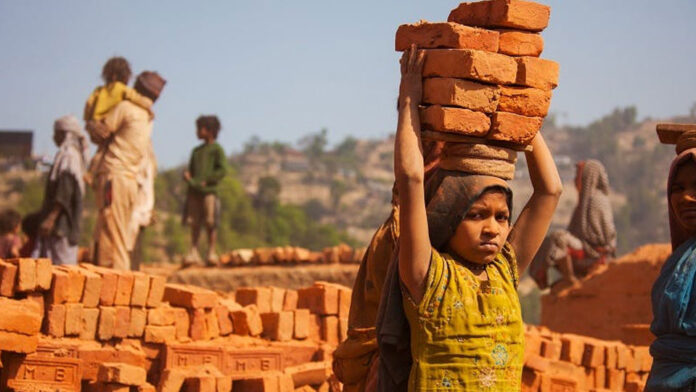Child labour in Pakistan represents a critical issue that affects millions of children, depriving them of their rights to a safe childhood, education, and healthcare. Despite the existence of international agreements and national legal frameworks designed to eliminate this scourge, the prevalence of child labour persists due to a complex interplay of cultural, socioeconomic, and enforcement challenges. Current estimates suggest that approximately 12.5 million children in Pakistan aged between 5 and 14 are engaged in child labour, reflecting a significant portion of the child population in this age group. This alarming statistic underscores the urgent need for comprehensive action to address the issue.
A vast majority of child labourers in Pakistan are found in rural areas, primarily working in the agricultural sector, which employs the highest number of children. In urban settings, children are often seen toiling in small-scale workshops, brick kilns, and textile factories, frequently exposed to hazardous conditions such as excessive working hours, physical strain, and dangerous machinery. These environments not only jeopardize their physical health but also impair their psychological development and future prospects. According to the International Labour Organisation (ILO), the global figure for child labourers stands at 152 million, with South Asia identified as a major hotspot. Countries like Pakistan, India, Bangladesh, and Nepal report some of the highest rates of child labour in the region. While efforts have been made to reduce child labour rates, progress has been uneven, and many children remain trapped in exploitative conditions. In response to this pressing issue, Pakistan has implemented a range of measures aimed at combating child labour. The Child Labour (Prohibition and Regulation) Act of 1986, alongside the Employment of Children Act of 1991, provides a regulatory framework for child labour. More recently, the Child Protection Act of 2018 has enhanced protective mechanisms for children, reflecting a commitment to uphold their rights.
National Action Plans have been established to improve educational access, raise public awareness, and strengthen enforcement mechanisms against child labour. Initiatives such as the Child Labour Schools under Pakistan Bait-ul-Mal and the National Education Policy have been designed to provide financial support to low-income families, improve school infrastructure, and enhance teacher training. Collaborating with international organizations like the ILO and UNICEF, Pakistan has sought to address child labour through research, policy development, and capacity-building initiatives. Despite these measures, numerous challenges hinder effective action against child labour. One of the most pressing issues is the weak enforcement of existing laws. Insufficient monitoring and oversight often allow employers to exploit legal loopholes, leaving children vulnerable to exploitation. The informal sector, encompassing small workshops, agriculture, and domestic work, presents significant challenges for regulation and enforcement.
Socioeconomic factors play a crucial role in perpetuating child labour. High levels of poverty and limited access to education compel families to rely on the income generated by their children. This economic necessity often outweighs the perceived benefits of education, leading to a cycle of poverty that is difficult to escape. Moreover, cultural attitudes towards child labour, often rooted in traditional practices, contribute to its normalization within communities, making it essential to engage in sustained awareness campaigns that highlight the importance of education. To effectively combat child labour in Pakistan, a comprehensive and multifaceted approach is essential. Strengthening legal frameworks is crucial, not only by enhancing existing laws but also by ensuring rigorous enforcement. Increasing penalties for violators and improving the capacity of labour inspectors will help create a more accountable system. Expanding educational opportunities is another vital aspect of this strategy. By making education more accessible, particularly for marginalized communities, the cycle of child labour can be disrupted. Initiatives aimed at improving school infrastructure, providing scholarships, and enhancing teacher training will be instrumental in encouraging families to prioritize education over work.
Addressing poverty through targeted economic development programs is also paramount. Providing financial support to vulnerable families and creating job opportunities can alleviate the economic pressures that drive children into the workforce. Moreover, community-based programs can promote skills development for adults, enabling families to achieve sustainable livelihoods without relying on child labour. Public awareness campaigns must also play a central role in changing cultural attitudes towards child labour. Engaging communities through workshops, seminars, and local media can shift perceptions, highlighting the long-term benefits of education for children and families alike. By fostering a culture that values education and child welfare, communities can begin to reject the normalization of child labour.
When comparing Pakistan’s situation to other South Asian countries, it becomes clear that progress has been made, but significant challenges remain. India, for instance, has implemented stringent laws and social programs that have successfully reduced child labour rates in various sectors. Bangladesh has focused on education and economic development, resulting in increased school attendance and financial support for families. Nepal has made strides through education and child protection initiatives, although economic challenges and natural disasters continue to pose significant hurdles. In contrast, Sri Lanka benefits from relatively lower child labour rates, attributed to higher levels of education, robust social welfare programs, and effective child protection mechanisms. Pakistan can identify effective strategies and best practices for combating child labour by examining regional examples. Collaborative efforts with neighbouring countries and international organizations can enhance Pakistan’s capacity. Addressing child labour requires the collective effort of all stakeholders, including NGOs, community leaders, parents, and the private sector, fostering partnerships for a holistic response.
Eradicating child labour is a profound commitment to the future of Pakistan’s children. It protects their right to a safe upbringing while fostering long-term economic growth through education and skills development. This effort champions human rights, gender equality, and social justice, aligning our nation with global standards. Once lost, childhood cannot be reclaimed, but we can create a world where every child grows up with joy and opportunity. A steadfast commitment to reform and community involvement is essential for a brighter, more equitable future. By prioritizing children’s welfare, Pakistan can strive for a society where every child has the chance to learn, thrive, and dream. This journey against child labour requires collective action from us all to make a child-friendly Pakistan a reality.





















